Museums & Institutions
Getting Lost in Tokyo’s New teamLab Experience
Where visitors might get a taste of the digital sublime.
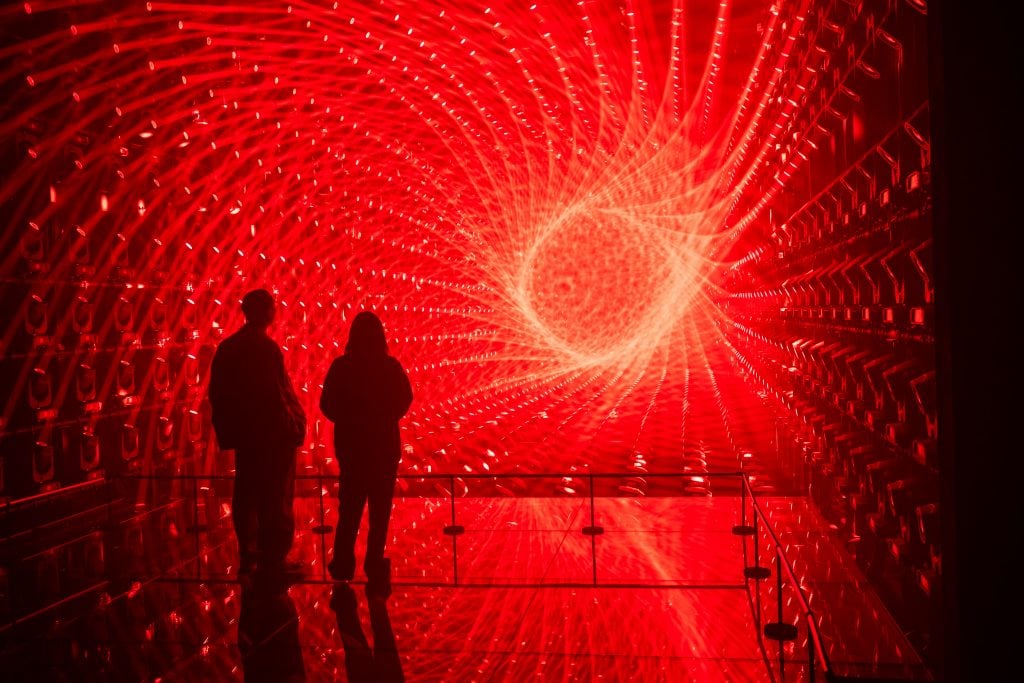
As I approached the entrance of the new teamLab experience in Tokyo’s Azabudai Hills, it became clear that the relocated “digital art museum” would be a feast for the eyes. As viewers snapped their photos out front in the designated spot, large black vinyl lettering, which stretched over the hallways in elongated forms, came neatly together to spell out “teamLab Borderless”.
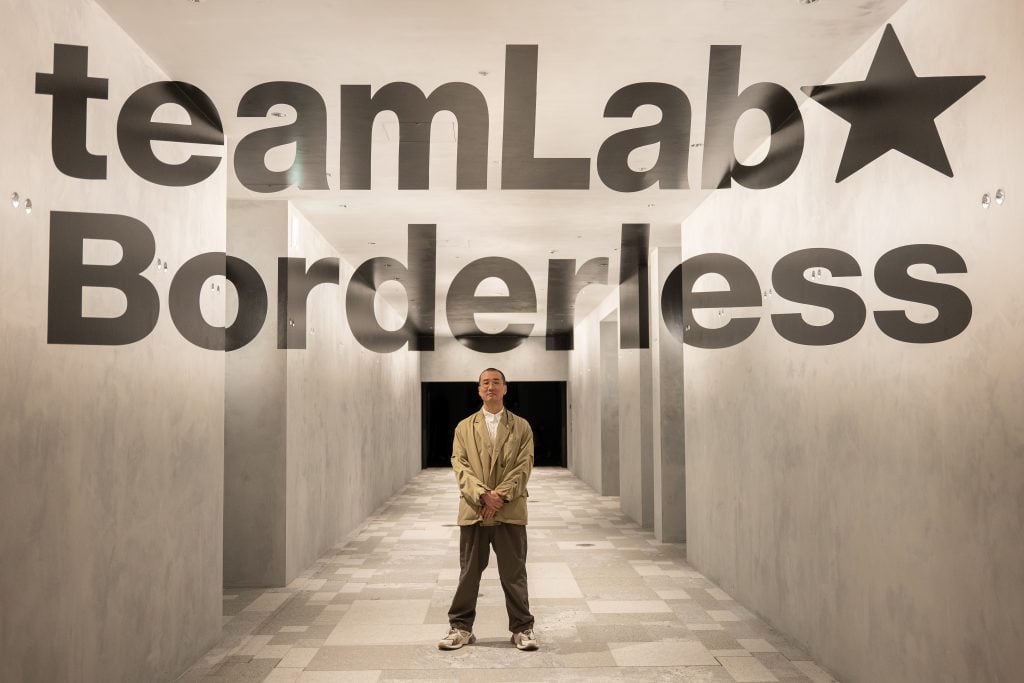
Communications Director Takashi Kudo in front of the exhibit entrance. Photo by Ralph Lumbres.
TeamLab, an international art collective known for its immersive and interactive projects that has enlivened the state of digital art, boasts some of the most-visited and most-googled art venues around the world. The original teamLab Borderless opened in 2018 in Odaiba, but due to redevelopment of the area it has moved to a new space in Azabudai Hills. While it features many familiar visual motifs and installations, the opening of this new venue also serves as an opportunity to further explore the concept of borderless.
When asked about specificities of how teamLab approached the new location, teamLab communications director Takashi Kudo replied, “When we create our projects, we try to create something that we believe in. And this time it’s about a borderless world. It’s not related to Azabudai Hills, it’s not even related to Tokyo, but rather about the experience of borderlessness.”
This thread, especially in the realm of perception, became clear through the multisensory experience, including sound and scent, and the multidimensional forms of interaction between the viewer and the artworks themselves.

Installation view, teamLab Borderless, featuring Flowers and People, Cannot be Controlled but Live Together – A Whole Year per Hour (2017). Photo by Ralph Lumbres.
Upon entering, I was greeted by Flowers and People, Cannot be Controlled but Live Together – A Whole Year per Hour (2017), a work in which floating flowers accompanied by the sounds of ethereal synthesizer pads moved around a multicolor-tinted room. Flowers that look like plum and cherry blossoms, ranunculi, irises and orchids all bloomed and faltered over the course of the visit, shifting to create the sensation of seasons. Butterflies, schools of fish, and flocks of white angelic crows jettisoned through the space and gave hints of what was to come.
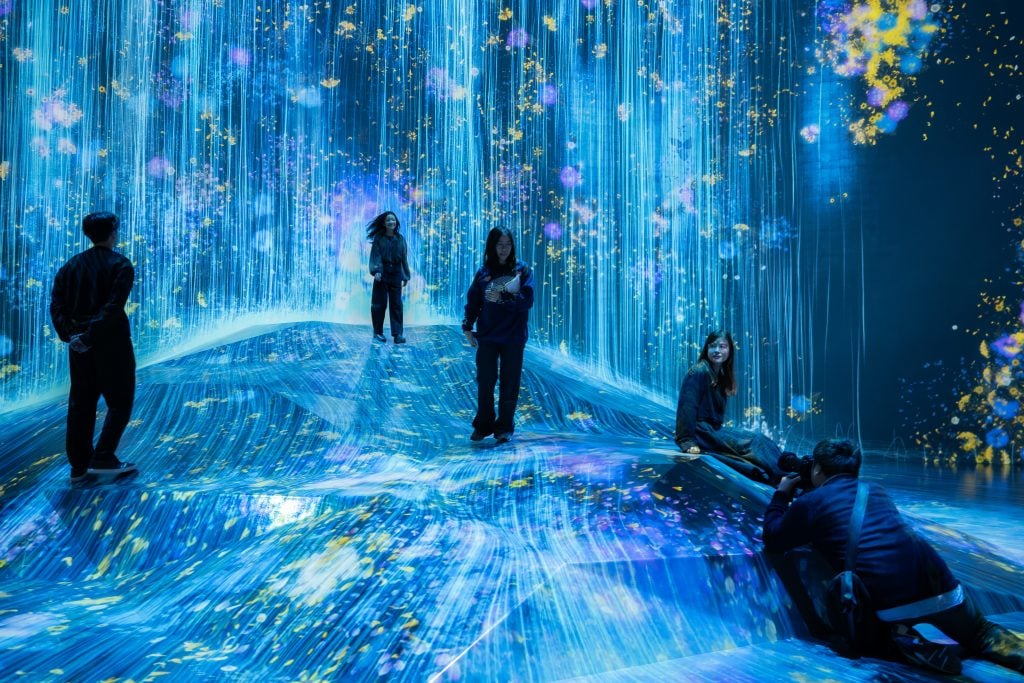
Installation view, teamLab Bordlerless, featuring Universe of Water Particles on a Rock Where People Gather (2013). Photo by Ralph Lumbres.
In a large central space, various works collided. At one point, Universe of Water Particles on a Rock Where People Gather (2013) materialized to show a waterfall, conceived through long strings of blue. The strands of water moved smoothly aside and around the viewer’s bodies. Later, in the same space, What a Loving, and Beautiful World – Unfolding (2019) projected calligraphic words that descended the walls for viewers to tap, and in doing so created corresponding scenes of mountains, trees, wind, fire, flowers, and birds.
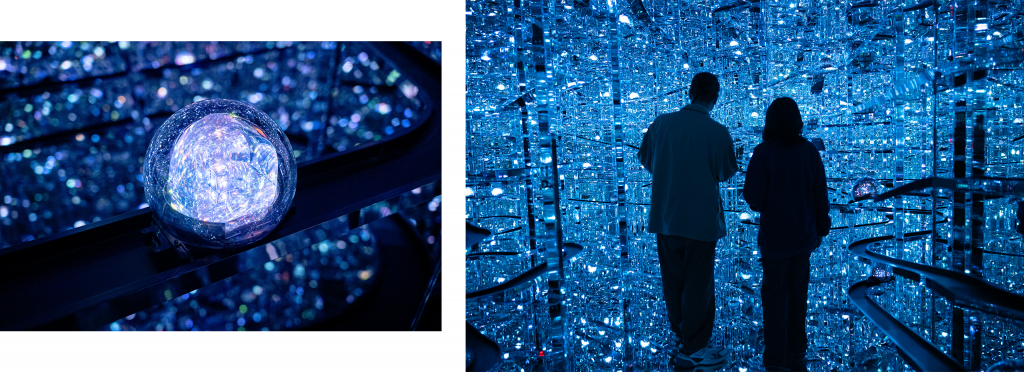
Installation view, teamLab Borderless, featuring Microcosmoses – Wobbling Light (2024). Photo by Ralph Lumbres.
Naturally, the technological underpinnings of the works spark interest, but teamLab doesn’t want its audience to get fixated on the mechanisms. Takashi Kudo explained, “Just like there is watercolor and oil paint, the works move between spaces and through mediums such as projection and L.E.D.” Technology for teamLab is a tool, but it is not the inherent message.
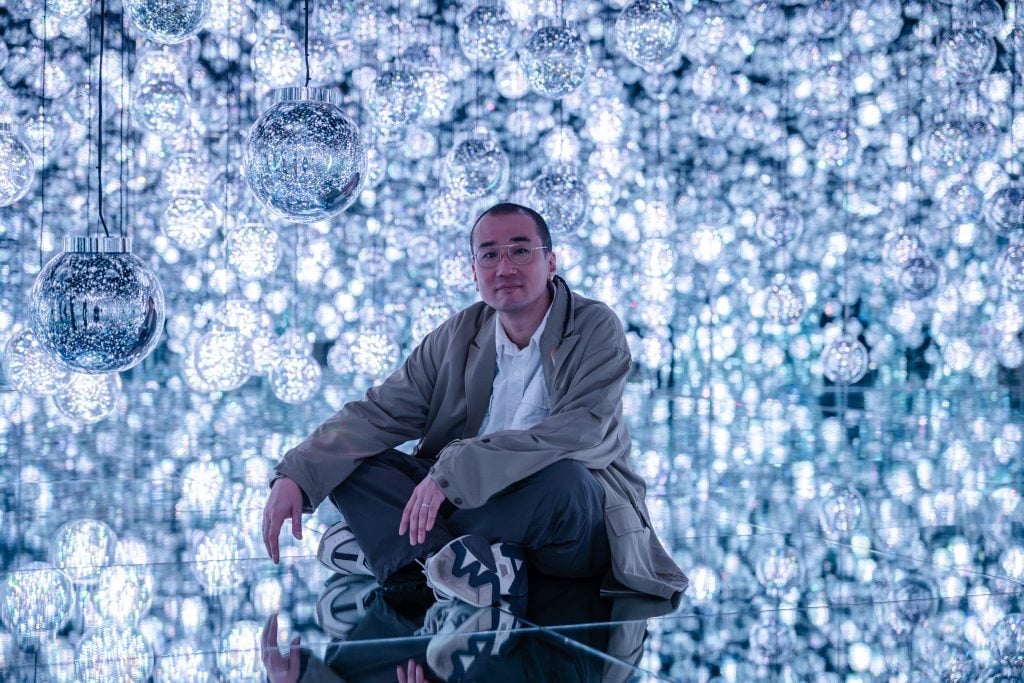
Portrait of Takashi Kudo. Photo by Ralph Lumbres.
In Microcosmoses – Wobbling Light (2024), spheres move along rails and cut throughout the space. The movement resembles an assembly line, with a calming sense of decorum and pacing. Kudo explained that this room has three orders, the first is the order of the spheres, which are a world unto themselves. They move at their own necessary speed and slow down when they need to charge. The second order is the viewer, who through being in the space affects the environment. The third is sound, which synthesizes everything. This way of viewing the work also highlights teamLab’s collaborative philosophy. Takashi sees himself as one of the spheres, which forms part of the whole in the teamLab collective, not above or below anyone else.
An essential element of teamLab Borderless experience is that it has no map, and because of this, it is a near impossible task to describe the beginning or endings of various spaces or artworks, or give any special insight on how to move around the space. In this way, without linear navigation and with plenty of deceptive mirrors and dark hallways, viewers are encouraged to get lost and command a certain level of control over their own experience.
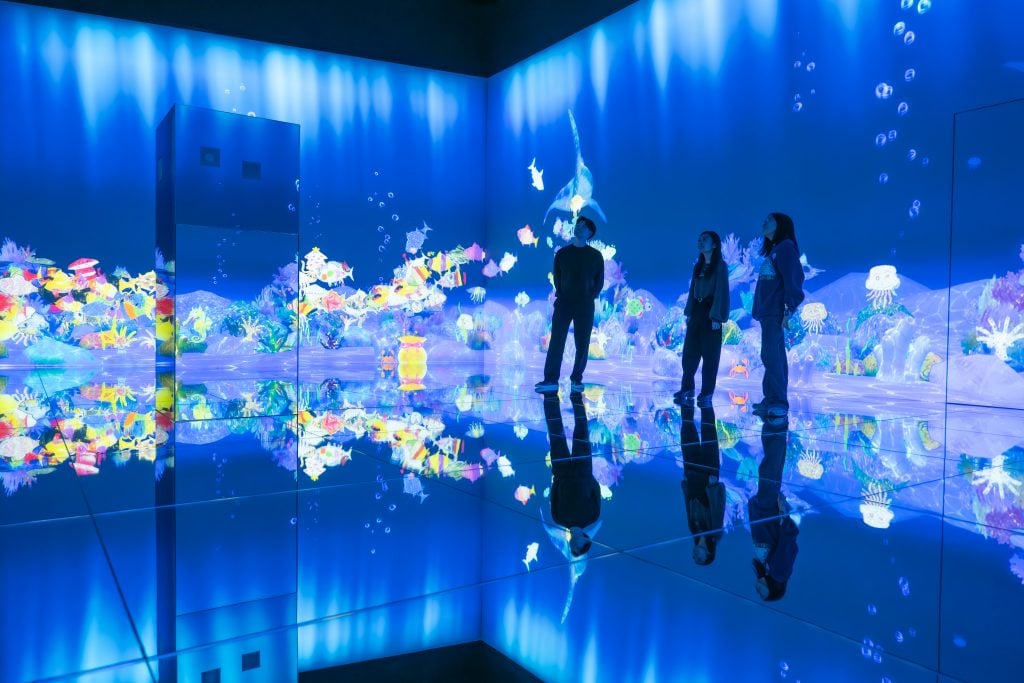
Installation view, teamLab Borderless, featuring The Way of the Sea: Cosmic Void (2018), Photo by Ralph Lumbres.
Viewers that are prone to motion sickness or overstimulation should be mindful of interacting with various artworks. In The Way of the Sea, Cosmic Void (2018), people step onto a slightly elevated platform and, in a motion reminiscent of the ocean floor, shift and bob around schools of fish, swaying branches and seafloor vegetation.
One of the clear highlights of the experience is Light Sculpture – Flow (2016), which existed at the previous teamLabs Borderless location and returns in its entirety. In this work, a room of lights refract on a perfectly distributed cloud of haze, thus conjuring moving geometries. To see the whole installation, with all its variations in its entirety, could take up to an hour, although the works are not on a set loop.

Installation view, teamLab Borderless, featuring Bubble Universe: Physical Light, Bubbles of Light, Wobbling Light, and Environmental Light – One Stroke (2023). Photo by Ralph Lumbres.
Another showstopper that fans will be glad to see again is Bubble Universe: Physical Light, Bubbles of Light, Wobbling Light, and Environmental Light – One Stroke (2023), in which viewers can enter a room full of light orb spheres that ignite as you come close, then draw a trajectory of light across the space in one stroke. The whole room hums in sighs of orange and red as it becomes populated. Another top contender is Infinite Crystal World (2018), in which long strands of LED lights play out a light show that reflects the elements of fire, water, air, and earth.
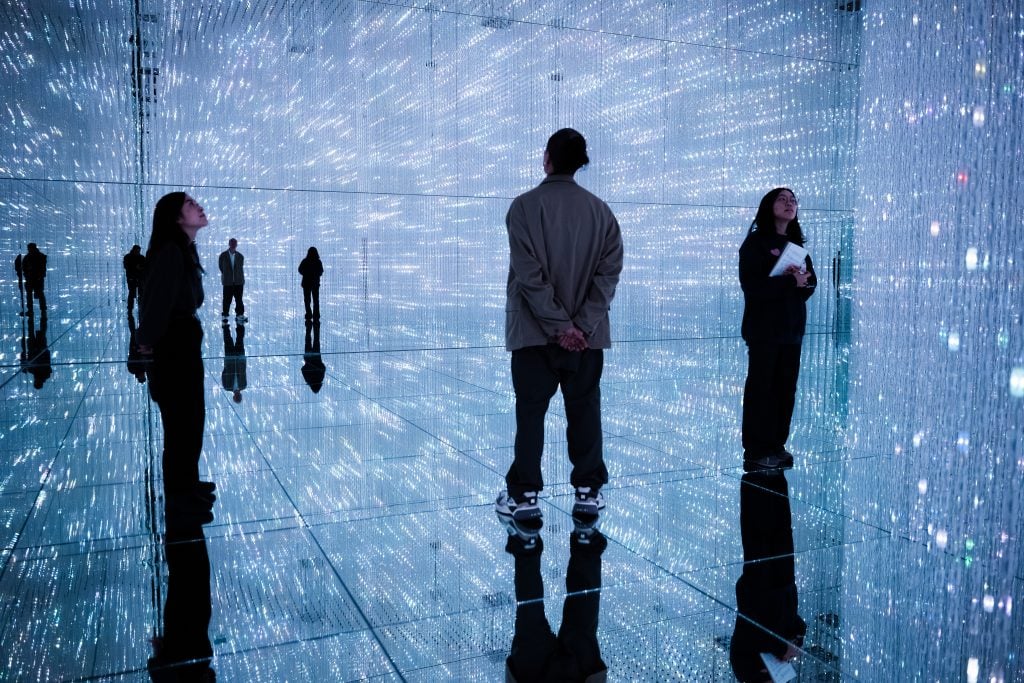
Installation view, teamLab Borderless, featuring Infinite Crystal World (2018). Photo by Ralph Lumbres.
TeamLab is wildly popular in essence because it embodies a rapture that is so rare in modern life. That we must experience this through cutting-edge technology might be a sore point for purists who ask that the sublime that is gifted by nature remains there. Nevertheless, teamLab creates an experience that allows viewers to fully take in an epicurean sensual delight, which fully challenges the senses and perception.





